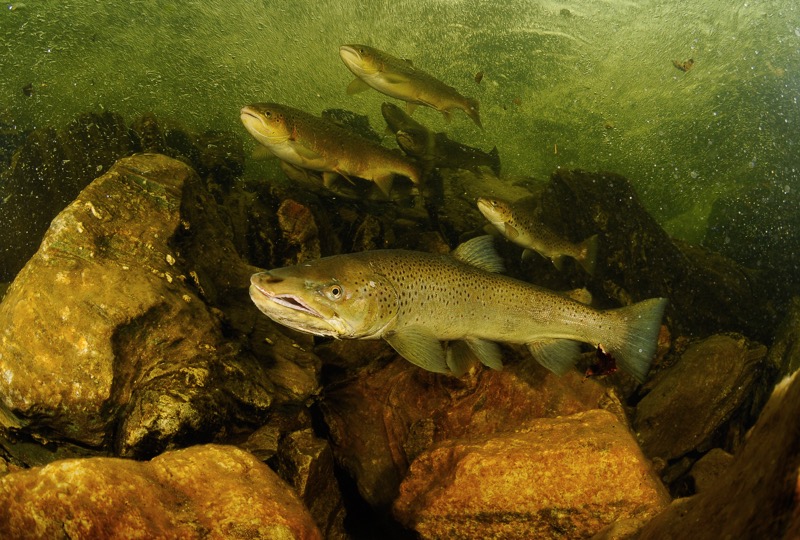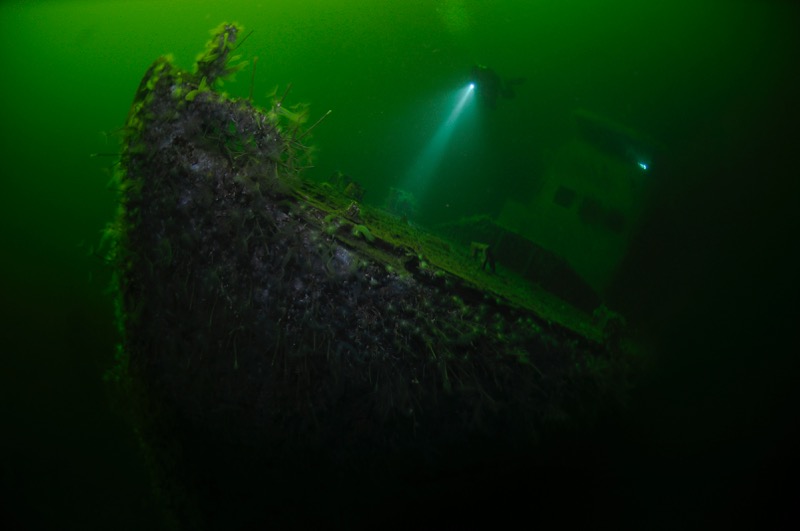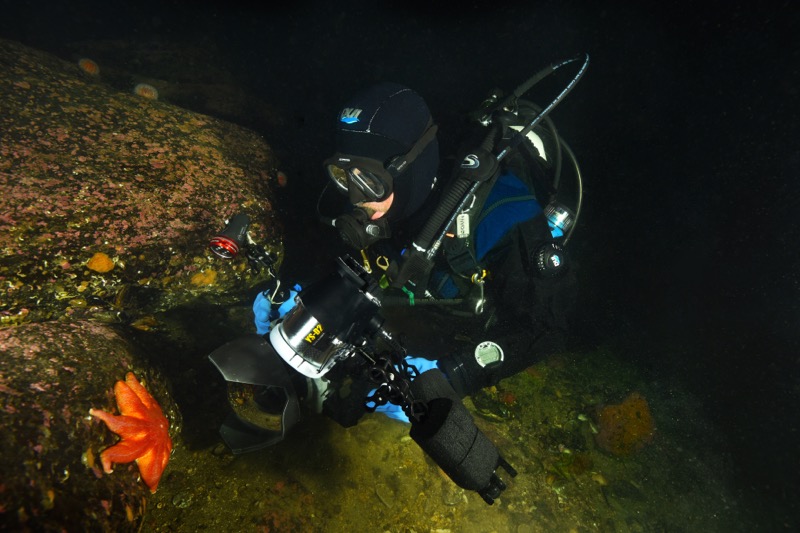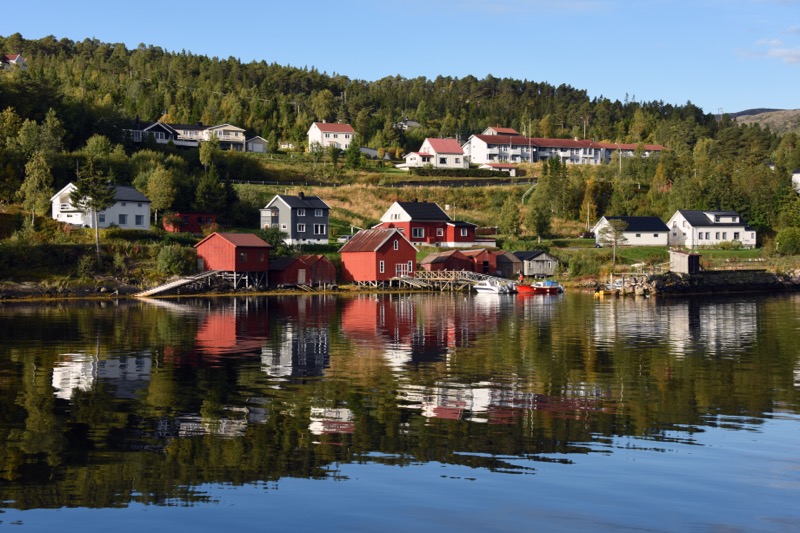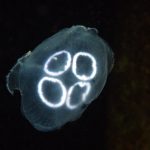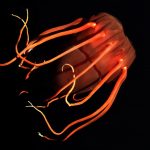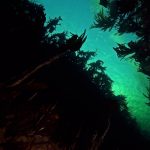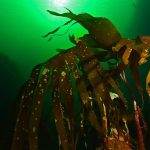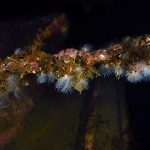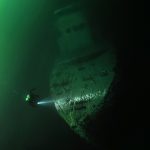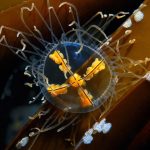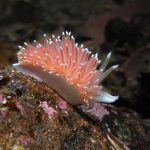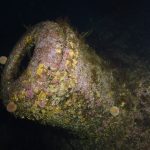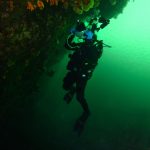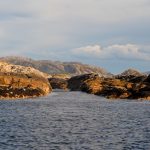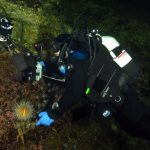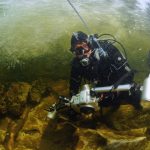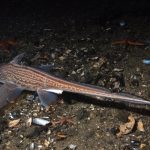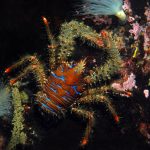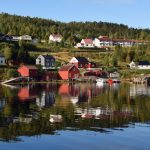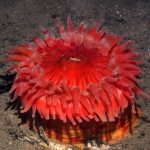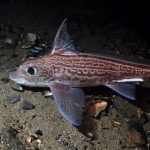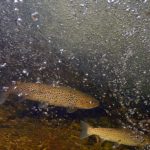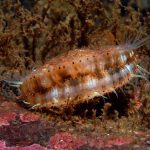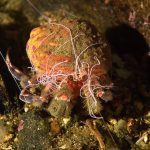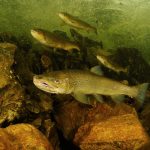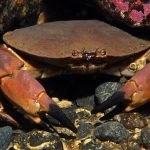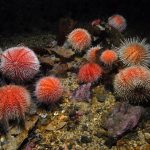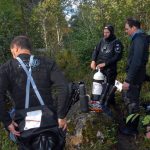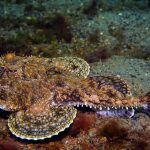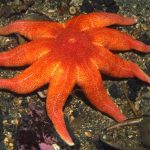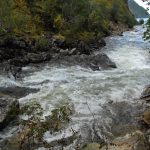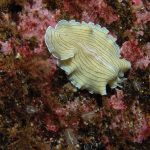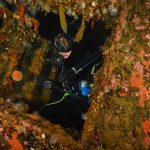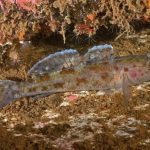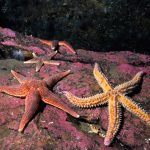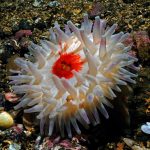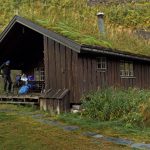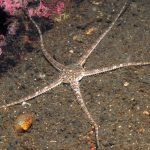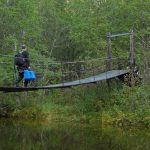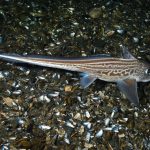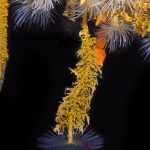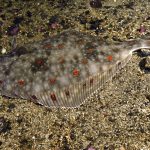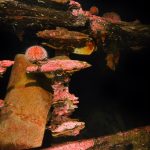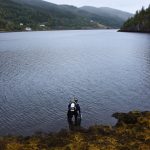It was quite a journey to get to this spot. A five hour drive into Nordland from Trondheim, a ½ mile trek through the forest to get the divers, dive gear and camera equipment to the dive site and a rope rappel down a 30-foot mud and rock slope to the river’s edge…and we were not yet in the water! As we looked over the tumultuous waters of the river rapids, we wondered if we really were going to dive in this roiling maelstrom. But that’s where the Salmon were, and our best opportunity to photograph them as they marched upstream to spawn was right below the white water rapids in a shallow pool where we hoped to catch a glimpse and snatch some images. So, after attaching a safety rope to prevent being whisked downstream, we dropped below the surface current to a relatively calm pocket of water and began the search for these remarkable fish. Above us the water tumbled at rocket speed but descending just a few feet below the surface got us out of the current.
Using large boulders and rocks to shield us from the furious flow, we pushed forward and before long we spotted our quarry: large, stocky Norwegian Salmon swimming furiously against the downstream current. After attempting unsuccessfully to leap up a small waterfall slightly upstream from this spot, many of them were now resting in this pocket of water and this represented our photographic opportunity. Still, this was not at all an easy task. Pushing the cameras through the force of the rapids, locking the focus of the camera onto the subject and squeezing off the desired shots took all of our effort. This was diving the frontier of Norway…and our expedition had only just begun.
Text by Michael Salvarezza and Christopher Weaver (Eco-Photo Explorers)
Photography by Michael Salvarezza, Christopher Weaver (Eco-Photo Explorers) and Sven Gust
For divers, Norway offers quite a palette of fascinating opportunities. Our journey to the land where Vikings once ruled took us to the north to search for Salmon, and deep into some of the fjords along the coast to explore historic shipwrecks, lush gardens of kelp and unique geological features. Along the way, we searched for rare and little understood deep-water organisms. Visitors to Norway are often impressed with the beautiful countryside, the warm and welcoming culture of the Norwegians and, if they are fortunate, the dazzling northern lights. But it is underwater where some of Norway’s true treasures, and best kept secrets, can be found.
After leaving the forest wilderness and our encounters with Salmon, we next arrived at Namsen Fjord, a picturesque fjord along the western coast of Norway 100 miles north of the city of Trondheim. Here, we first explored the sunken wreck of the M/S Hamo, a freighter sunk in a local harbor in 70 feet of water. The wreck is covered with myriad organisms and offers terrific photographic opportunities in an easy setting. In reality, though, diving the M/S Hamo is just a tune-up for a dive on the HMT Aston Villa.
The Aston Villa was originally launched as a fishing trawler but was requisitioned in September 1939 to serve as an anti-submarine vessel during the Second World War. She came under heavy fire off the Norwegian coast in May 1940 from German forces and suffered significant damage. Considered unable to cross the North Sea to reach safety and repair, she was then intentionally sunk alongside the steep wall of the fjord to avoid having the ship come into enemy hands. Today, a dive on this wreck represents a descent into a little known aspect of Norwegian history. The wreck lies on a sharp downward angle, with its mangled stern section reachable in relatively shallow water at 60 feet and its intact bow at 95 feet pointing to deeper water.
After exploring these wrecks, we turned our attention to the mouth of the Fjord where it reaches the open Norwegian Sea. Here, along a rocky coast strewn with boulders and small islands, we prepared to dive lush gardens of kelp in search of Wolf Fish, Anglerfish and other endemic critters. Descending into 60 feet of clear, cold North Atlantic water, we swayed gently in the surge while we explored cracks and fissures, photographing invertebrates and small fish. This area of Norway is little explored underwater. Virtually any spot along the coast could represent a compelling dive site and more are being discovered all the time. Still, unlike other established destinations, only a few divers have seen the dive sites here and they are so new and unexplored that don’t even have names.
Our journey into the Norway’s underwater frontier continued in the Trondheimfjord. Here, in a dramatic setting alongside quaint cottages and rural sheep farms, we began our search for rarely seen and photographed deep-water organisms. Although the fjord appears relatively narrow, the sharp walls of the surrounding landmass drop precipitously to hundreds of feet of water just a short distance from shore. It is here, in certain areas washed with current-swept waters, that divers have the opportunity to encounter deep-water medusae, deep and cold-water corals and even the mysterious Ghost Sharks in depths attainable by divers.
Our first dive here started on a cold and dreary rainy day. As we descended into the deep, however, the surface weather receded from our minds and we began our search for the large, colorful deep-water medusa. Swimming along a silty, rocky bottom we passed over brittle stars, colorful cold-water anemones and various invertebrates before reaching a depth of about 90 feet. Suddenly, like an apparition in the night, the deep red bulbous bell of a Medusa, fully 18 inches in diameter, appeared out of the dim edge of visibility. Upon closer inspection, we observed the strange tentacles and pulsating underbelly as the weird creature drifted by in the current. Then, as our eyes quickly adjusted to the low light, we spotted another…and another! In the end, we photographed a number of these fascinating creatures, all of various sizes and all drifting languidly in the current from the unlit depths to destinations unknown.
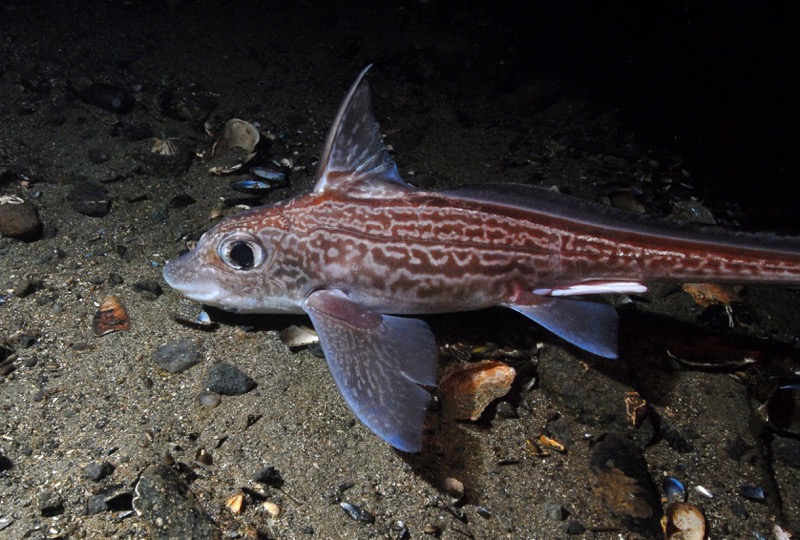
Ghost Sharks are deep water fish that can be seen in diveable depths in certain isolated spots in the Norwegian fjords
Our final objective in these cold Scandinavian waters was to observe and photograph the mysterious Ghost Sharks of Norway. Often referred to as Chimeras, these are deep-water cartilaginous fishes related to sharks and rays often found in waters as deep as 8000 feet or more. Ranging in size from 24 to 80 inches in length, they are characterized by large eyes, two dorsal fins, and a long, tapering slender tail. There are 28 different species worldwide, but the ones we sought in Norway are known to only rise to diveable depths in a few select areas of the fjords. They emerge at night, presumably in search of food, which for the Ghost Shark, consists of shellfish and small fish. Because of the treacherous tidal movement in the fjord, our dive had to be timed to slack water after high tide…which meant that at 11:30 on a rainy night we hiked down a steep slope through the shoreline woods to the entry point for our dive. Once in the dark water, we began a 20 minute swim at 90 feet before we suddenly spotted a silvery flash in our lights: A Ghost Shark! Local experience has established that these sharks tend to hunt alone, with divers encountering one at a time along the sandy slope of the fjord. Individual sharks are often separated by some distance but on this evening, something brand new was observed. Here, 90 feet below the surface of the darkened fjord, we found a veritable shoal of Ghost Sharks. About a dozen individuals were congregating in the same area of the fjord and the reason for this gathering is really subject to speculation. Perhaps they were mating. Perhaps they were exhibiting some other behavior. Regardless of why, this dive was sure to add to the general knowledge base of these strange and mysterious specters of the deep!
Whether it is straining to capture glimpses of migrating Salmon in the river rapids, exploring historic shipwrecks and undiscovered dive sites in the fjords, or searching for little known and rarely seen deep water marine life, diving in Norway truly represents a journey to an underwater frontier.
Our expedition took place as the seasons were beginning to transition from summer to autumn. Walking down a country lane after our final dive, the approach of winter was evident in the air. The wind was blowing forcefully through the birch and evergreen trees and the howling rush of cold air through the trees was a harbinger of tougher weather to come. But as the residents of Norway were beginning to prepare for the long arctic night, underwater in the fjords and rivers of this land, life goes on, marching to a timeless rhythm that is the same today as it was in the days of the Vikings. There is much to explore and discover still in these waters. This is the frontier.
Getting There
Most international visitors to Norway arrive into the airports at Oslo or Bergen. There are domestic flights to Trondheim, and other destinations, which will bring divers closer to the remote sites in the north. Most passengers do not require a Visa to enter Norway as long as their stay does not exceed 3 months. Norway is a member of the Schengen group of countries (named after the treaty that allows free movement between EU countries) so there are limited border controls if you are arriving from one of these member countries.
Transport to other regions in Norway can be accomplished either by driving or through domestic air travel.
Baggage
Baggage allowances vary for each international carrier, so check before you leave! Note: Some international carriers are now enforcing weight and size limits for carry-on bags as well what is considered a personal carry-on type of bag.
Weather
Because of the moderating influence of the Gulf Stream, Norway enjoys a surprisingly temperate climate. The warmest temperatures are generally in July and August and the coldest occur between December and March. Bergen is the wettest city with 2250mm of rainfall on average per year. Visitors to Norway should be prepared for sudden changes in the weather as the climate is very variable.
Currency
The Norwegian currency is Norwegian Kroner (NOK). 1 NOK is divided into 100 øre (cents).
Electricity
Voltage: 220-240V/50Hz
Primary Socket Type: Europlug, Schuko
Travel Adapter: Round Pin Universal Plug
Scuba Diving
Contact Northern-Explorers for more information on specialized dive expeditions to the north of Norway, Svalbard and Greenland. www.Northern-Explorers.com. The cost of the expedition described here is 2.450 euro per person, which includes all diving and accommodations as well as two meals per day. There are other expedition options available in Norway so please contact Northern-Explorers for details.
Accomodations
Expedition diving in Norway involves access to remote locations. Included in the price of these specialized expeditions are all accommodations in twin rooms, including breakfast and dinner. Accommodations are typically in comfortable cabins located near to the dive sites.
Oslo has a recompression chamber.
Photo Gallery (Click a photo to enlarge):
- The Aurora Borealis over a Norwegian Fjord (Photo by Sven Gust)
- The ghostly remains of s shipwreck emerges from the dark water of the fjord (Photo by Sven Gust)
- A Moon Jelly drifts through the fjord at night
- Alien looking deep water Medusae emerge at night in the Trondheimfjord
- A sharp cut in the coast creates a unique dive opportunity
- Kelp gardens extend along the coast of Norway providing endless diving opportunities
- Tube worms have taken up residence on the Aston Villa wreck
- Christopher Weaver exploring the kelp gardens
- Diving on a wreck inside a fjord (Photo by Sven Gust)
- This species of jellyfish was seen in the kelp gardens of Namsfjord
- A diver photographs a starfish in the fjord
- Nudibranchs, like this Flabellina nobilis, make for great photographs for divers in Norway
- Divers can find the Atlantic Wolffish (Anarhichas lupus) in the kelp gardens of Norway
- The Aston Villa wreck is a reminder of the horrors of World War II
- A diver explores the rocky coast of Norway near Namsfjord
- The rugged Norwegian coast near Namsfjord provides endless opportunities to discover new dive sites
- Author Christopher Weaver explores the rocky walls of the Namsfjord
- A diver battles the swift river currents to pursue photographing Norwegian Salmon
- A diver explores a rocky crevice along the coast
- The Sea Spider is so slender that it contains its body organs in its legs
- The Chimera, or Ghost Shark, is a cartilaginous fish whose closest relative is the shark.
- A brilliantly colored Squat Lobster appears on a night dive in a Norwegian Fjord
- The Norwegian countryside along the shores of a fjord
- Cold water anemones abound in these fertile waters
- Ghost Sharks are deep water fish that can be seen in diveable depths in certain isolated spots in the Norwegian fjords
- The urge to find a suitable spawning ground is powerful for the Salmon
- Brilliantly colored anemones stand out on the rocky reefs
- Wild Norwegian Salmon are difficult to photograph as they navigate the river rapids
- Bivalves, like this scallop, thrive in the clean waters of Norway
- Divers should beware of the spines of the sea urchins
- The hermit crab is entangled with the legs of a hitchhiking anemone
- Norwegian Salmon have an irrepressible urge to spawn in the rivers of Norway
- This crab is searching for its next meal in the Trondheimfjord
- Clusters of sea urchins are frequently found in the fjords
- Divers prepare to enter the river in search of Salmon
- The Longspined Anglerfish (Lophius piscatorius) can be found in the kelp gardens along the Norwegian coast.
- A robust looking starfish searching for its next meal
- The dive site looks formidable!
- Macro photographers rejoice in finding colorful nudibranchs to photograph
- Atlantic Wolffish (Anarhichas lupus) look fearsome but are harmless
- Cold water anemones come in riotous color schemes!
- Author Christopher Weaver explores the wreck of the M/S Hamo
- The M/S Hamo wreck is home to this colorful Goby
- Invertebrates such as these starfish are plentiful in the coastal waters of Norway
- Hermit Crabs and other small crustaceans inhabit the waters of Norway
- Cold water anemones have dazzling patterns of color
- Wilderness diving in the Norwegian countyside
- Brittle Stars are a strange looking inhabitant of these cold waters
- A diver treks to the river dive site in search of migrating Salmon
- Ghost Sharks are rarely seen by divers but in Norway there are opportunities to encounter them in 100 FSW
- To find the ideal spot to observe Salmon, divers hike a narrow and winding path through the forest
- A group of Brittle Stars on a rock in the Trondheimfjord
- The M/S Hamo is covered with tube worms
- Starfish come in many shapes, sizes and colors in Norway
- Norway is home to many species of flatfish, including this colorful Flounder
- The wreckage of the M/S Hamo
- A diver prepares to explore the expanse of the fjord
__________________________________________________________


